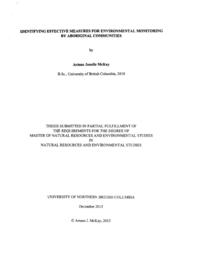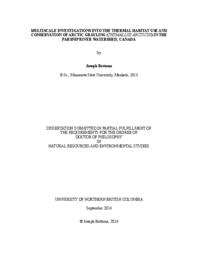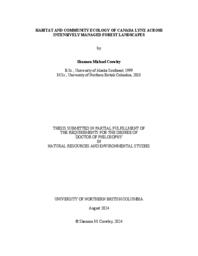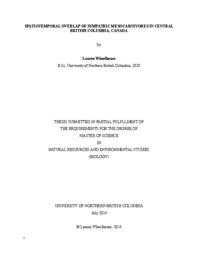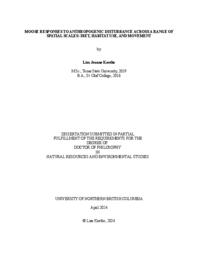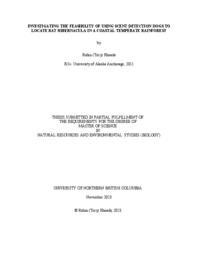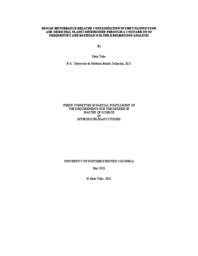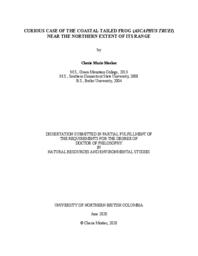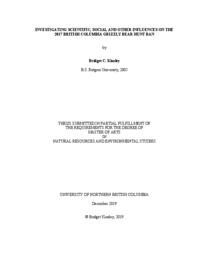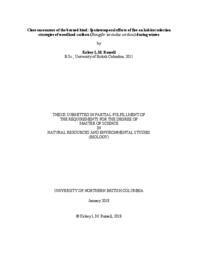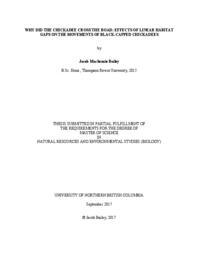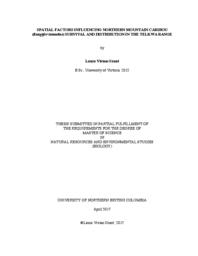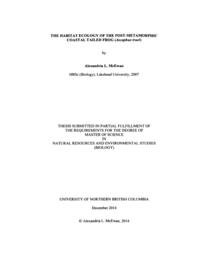Johnson, Christopher Jack
Person Preferred Name
Christopher Jack Johnson
Related Works
Content type
Digital Document
Origin Information
Content type
Digital Document
Origin Information
Content type
Digital Document
Origin Information
Content type
Digital Document
Origin Information
Content type
Digital Document
Origin Information
Content type
Digital Document
Description / Synopsis
Habitat loss and climate change are two of the leading causes of the global decline of biodiversity. Declines in the abundance of moose (Alces americanus) in British Columbia, Canada, in the 2000s were hypothesized to result from an interaction between a severe climate-induced insect outbreak and resulting increases in salvage harvest of affected forests. I investigated the behavioral and distributional responses of moose to forest harvesting disturbance across a range of spatial scales and tested the use of N-mixture models and camera trap data to estimate population abundance. At a fine spatial scale, I used microhistological analysis of moose fecal samples to assess the effects of logging on the diet of moose. In areas with greater intensities of forest harvesting, moose consumed fewer forbs, shrubs, and fir trees, and their diet was more diverse. These dietary responses were consistent with the Niche Expansion Hypothesis, which predicted that a generalist herbivore would eat a greater diversity of plants to compensate for decreased availability or quality of preferred forage. I used LiDAR and GPScollar data to test hypotheses that explained the use of horizontal and vertical cover by moose. Risk of predation and hunting (Direct Mortality Hypothesis) was the primary factor that influenced the use of cover. Moose used different forest structures, ranging from open to closed, depending on the threat (predation or hunting) and their response was modulated by maternal status. At a coarser spatial scale, I assessed a suite of hypotheses concerning the causes of partial migration, effects of migration on habitat used, and fitness effects of migration. Wildfire disturbance in the winter range was the primary driver of migration and most migratory moose experienced less wildfire disturbance after leaving their winter range. Migrants displaying specific movement tactics (e.g., distance and timing of migratory movements) experienced increased probability of parturition and neonate survival. Migration exposed moose to increased risk of predation but residents were more vulnerable to health-related causes of mortality. While migration provided some moose with fitness benefits, it did not fully mitigate the amount of wildfire disturbance in the summer range, particularly after severe wildfire seasons. Finally, I tested the sensitivity of estimates of population abundance produced by N-mixture models parameterized with camera trap data to ecological conditions, spatial scale of covariates, the potential for temporally non-independent detections, and model choice based on parsimony. Nmixture models produced accurate and reasonably precise estimates of abundance of moose and were robust to model formulation, the spatial scale of associated covariates, and the criteria used to define independent detection. However, I recommend avoiding measures of parsimony for selecting the model or models to generate a population estimate. In total, the results of my dissertation suggest that land management and forest harvest should maintain forest communities that vary in structure and composition. In particular, large-scale disturbance can alter the diet of moose, expose maternal moose to increased risk of mortality, and, in the case of wildfire, it could lead to a decline in migratory behaviors and populations.
Origin Information
Content type
Digital Document
Description / Synopsis
Caribou (Rangifer tarandus) are declining worldwide. Across Canada, numerous populations have been extirpated over the past 50 years. In many cases, the mechanism of these declines is unsustainable predation exacerbated by apparent competition. Apparent competition occurs when alternate prey species, primarily deer (Odocoileus spp.) and moose (Alces americanus), increase in distribution and abundance, resulting in increased populations of predators (e.g., wolves (Canis lupus), cougar (Puma concolor), bears (Ursus spp.)) that are shared with caribou. Despite the role of white-tailed deer (Odocoileus virginianus) in apparent competition and caribou declines, relatively little is known about the resource use of this ungulate, or other apparent competitors, in west-central Alberta, Canada. I used GPS-collar locations from 2018–2022 in west-central Alberta to compare the habitat selection of whitetailed deer and mountain caribou. I then used DNA metabarcoding of fecal pellets collected in 2016 and 2022 to evaluate the diet of white-tailed deer and mountain caribou, as well as mule deer (O. hemionus), moose, and elk (Cervus canadensis) during winter. I found anthropogenic and environmental factors that may contribute to spatial overlap, or separation, between whitetailed deer and mountain caribou. Deer avoided areas with greater snow cover during winter and selected for forage availability during summer. Conversely, caribou had a non-significant response to snow cover and avoided valley bottoms but selected for ridgelines (alpine) during both seasons. I found relatively little overlap among the winter diet of the five sympatric ungulates. However, certain forage items including the Fabaceae and Lentibulariaceae families were abundant in the diet of all five ungulates and may result in shared resource use. I found DNA of lichenicolous fungi in the diet of caribou, but also white-tailed and mule deer, moose, and elk. My results provide new information on how deer, moose, and elk use the landscape in west-central Alberta, and how that compares to mountain caribou. Similarities in the spatial and diet overlap of sympatric ungulates can help inform strategies designed to mitigate the impacts of apparent competition for caribou.
Origin Information
Content type
Digital Document
Description / Synopsis
Little brown bat (Myotis lucifugus) populations have dramatically declined in North America as a result of white-nose syndrome, a fungal pathogen. The identification and protection of hibernacula is important to conservation efforts for the species. Little brown bats in western North America use a greater variety of hibernacula structures than their conspecifics in other portions of the continent, however relatively few have been identified. Existing techniques for locating hibernacula are limited and not conducive to all habitats; new methods are needed. The objectives of my research were to investigate whether a combination of scent detection dogs and game cameras at rocky outcrops could identify entrances to little brown bat hibernacula occurring in the Milieu Souterrain Superficiel (MSS) of Southeast Alaska during summer swarming. Additionally, I described swarming activity at swarming sites and hibernacula in Southeast Alaska to determine if specific behaviours during swarming were likely to be predictive of hibernation at that site. Using trained scent-detection dogs and game cameras, I identified six new hibernacula along ridges where bats were known to overwinter. Using cameras, I found that sites where bats were observed making u-turn behaviours were later used for hibernation, and that sites where circling and crawling behaviours were observed were less likely to be used as hibernacula. When bats were recorded at sites during the swarming period was also related to whether sites were used over winter; sites with more videos recorded during 26 August ̵ 8 September were more likely to be used as hibernacula. I conclude that it is possible to use scent detection dogs and game cameras at crevices during summer swarming to identify hibernacula in the MSS. Surveying with dogs will be most effective in areas with accessible habitat with recent bat use. A multipronged approach incorporating multiple tools, such as using radiotelemetry to broadly identify areas to search or using acoustic detectors to monitor bat activity levels prior to surveying, may increase the efficacy of the method.
Origin Information
Content type
Digital Document
Description / Synopsis
Forest ecosystems and the ecological services they provide are complex and dynamic. Disturbance and successional processes impact habitat for animals such as caribou (Rangifer tarandus caribou Gmelin 1788, Banfield 1961, 1974) and moose (Alces alces L.). The forested winter habitat of the Tweedsmuir-Entiako caribou herd has been significantly affected by recent disturbance. In order to evaluate the mid- and long-term consequences for habitat, we require an understanding of how habitat attributes change as stand structure changes over time. I developed a framework to link a stand dynamics model (SORTIE-ND), via linker functions, to three ecosystem elements relevant to caribou populations: terrestrial forage lichen, moose forage, and vertical cover. I first used SORTIE-ND to model stand structure dynamics following mountain pine beetle (Dendroctonus ponderosae Hopkins) attack and clearcut harvesting. I developed linker functions and refined them with empirical data. These functions were applied to stand structure output from SORTIE-ND to project the response of habitat to the disturbance agents. I addressed three questions: 1. What is the influence of edaphic site on the provision of elements of caribou habitat over time? 2. What is the influence of stand type on the provision of elements of caribou habitat over time? 3. How do recovery trajectories of caribou habitat elements differ in response to disturbances such as mountain pine beetle and clearcut harvest? I found that site and stand type interacted to influence the suitability of terrestrial lichen, moose forage and vertical cover. Poor productivity sites were most favourable for terrestrial forage lichen. Higher productivity stands and broadleaf stands provided the greatest suitability for moose shrubs. Both mountain pine beetle attack and clearcut harvest improved stand suitability for lichen and moose browse though for different sites and stand types. Interestingly, I found that severe mountain pine beetle attack resulted in conditions that favoured forage lichen for longer than clearcuts. Clearcuts resulted in conditions that were more suitable than mountain pine beetle attack for winter forage for moose. When operating on landscapes with caribou winter habitat, forest managers should consider disturbance history, the distribution of sites and stand types, silviculture systems and the future desired state of ecosystem services. The SORTIE-ND modelling framework could be used to support the evaluation of alternative management decisions in caribou winter habitat including alternative silviculture strategies. This approach could also provide stand- and site-specific trajectories of the recovery of caribou habitat that could be applied to habitat supply models.
Origin Information
Content type
Digital Document
Description / Synopsis
Increased development in forestry, oil and gas, road infrastructure, and agriculture sectors across the Swan River Watershed (Alberta, Canada) has led to an increase in the impact they have on the riparian and aquatic ecosystems. These industries require the removal of vegetation for construction and operation, and some do not require buffer zones around waterbodies to protect aquatic habitat. These industries also use herbicides and fertilizers that may contain high levels of heavy metals, as well as glyphosate. In this thesis, I examined the changes to abundance of plant species chosen by Knowledge Keepers of the Swan River First Nation, as well as general plant categories (i.e., shrub, trees, and herbaceous), in relation to industrial development. I also examined how heavy metal and glyphosate content changed in these plant species with distance from industrial development. Sixty-seven sites were sampled across the Swan River Watershed, each with seven transects examining plant abundance. Tissue samples of chosen species were collected on the first, fourth, and seventh transects. I found significant ( = 0.05) changes to the abundance of aquatic and riparian plant species and categories in association with industrial activity. I also found significant ( = 0.05) changes to heavy metal concentrations in response to industrial presence and distance. There was a significant ( = 0.05) increase in the presence of glyphosate in plant species when forestry or agriculture were present at a site. These results were obtained after conducting a comparison of multiple Bayesian and frequentist regression analysis. There has been an increased interest in Bayesian analysis in ecology, however there is still some hesitation around its implementation due to hardware and software costs, time, and education. The Bayesian method resulted in smaller root-mean-squared-errors and increased precision. I also found that the time and costs were the same as the frequentist analysis, when using a dataset collected over one field season. The biggest barrier in the implementation of Bayesian analysis was the lack of accessible education through formal university courses.
Origin Information
Content type
Digital Document
Description / Synopsis
Bear viewing poses significant risks for humans and wildlife, particularly in the form of "bear jams" - traffic congestion caused by people slowing down or stopping to view bears. This study addresses gaps in our understanding of the human dimensions of roadside bear viewing, focusing on the case study of Peter Lougheed Provincial Park (PLPP) in Alberta, Canada. A mixed-methods approach is employed in this study, comprising a survey (n=380) of visitors who have witnessed or engaged in roadside bear viewing and interviews with experts who have experience in bear-related fields (n=22). The main findings indicate that a balanced approach is needed to manage bears and humans. The study suggests human, bear, infrastructure, and habitat-related approaches, including implementing no-stopping zones, enforcing regulations, and improving education and outreach, are key to managing roadside bear viewing. The results of this study provide valuable insight for park managers and wildlife officials to develop effective management strategies that balance the needs of both humans and bears. The data collected in this study underscore the importance of a holistic and adaptive management approach to addressing roadside bear viewing. The findings apply to PLPP and parks facing similar challenges
Origin Information
Content type
Digital Document
Description / Synopsis
Global ecosystems are increasingly affected by climate change leading to alterations in expected disturbance regimes. Outbreaks of irruptive insect pests represent some of the most destructive disturbance events possible that occur in the forests of North America. The mountain pine beetle, Dendroctonus ponderosae Hopkins (Coleoptera: Curculionidae) (MPB), an irruptive tree-killing pest of several species of pine, is responsible for the most damaging insect outbreak in recent history in western Canada, leading to a massive range expansion from established territory in British Columbia to pine stands in central and northern Alberta during the mid-2000s. The adaptive genetic structure of these new populations is relatively unknown a decade after range expansion and the selective response of the beetle to novel habitats is likewise understudied. There is increasing concern among forestry stakeholders that MPB may develop novel genetic traits or behaviours in response to their new habitat. In this study, I sampled beetle DNA and used double-digest restriction fragment genotyping-by-sequencing to generate single nucleotide polymorphism (SNP) loci. I used these data to investigate the establishment of genetic structure throughout the newly expanded and historic MPB range. I identified two distinct genetic clusters, a southern cluster for beetles located south of Banff National Park and a northern for beetles located north of the park. The data presented here suggest that Jasper National Park and the surrounding region represents an area of admixture between the two genetic clusters, caused in part by the movement of beetles from both the north and the south. This area of admixture may have the potential to differentiate into a separate third genetic cluster. Outlier analysis indicated that several landscape variables including mean annual precipitation and relative humidity contributed to the selective pressures on MPB, while frost free period contributes to the genotypes of beetles from the expanded range in central and northern Alberta. We also found that novel colonized MPB sites caused by in-flights from BC to Alberta did not display changes in genetic structure from their source population. Semivoltine MPB new adults collected from a site within the admixed zone near Jasper National Park displayed accumulation of cryoprotectants in response to cooling autumn temperatures but are not capable of surviving below -30℃. This is the first time that new adults have been demonstrated to cold harden, but also indicates that beetles from the admixed zone are likely not displaying aberrant forms of dispersal, host selection, or cold tolerance. I propose that beetles within the expanded range are not experiencing extreme selection events that would lead to genetic changes that will cause notable colonization, gustation, or dispersal differences to that of their counterparts in the historical range of BC. Warming climate is likely to contribute to beetle survival throughout central and northern Alberta, however, MBP populations will likely reach an endemic state and display historically expected population cycling (endemic to epidemic to endemic) in the future. The homogenous nature of MPB genetic structure throughout the expanded range does not support the development of populations-specific control techniques.
Origin Information
Content type
Digital Document
Description / Synopsis
Advancements in animal tracking technology and analytical techniques have expanded the disciple of movement ecology. An improved understanding of where, when, and why an animal moves can greatly assist in the management and recovery of endangered species. White sturgeon (Acipenser transmontanus) in the Upper Columbia River (UCR) are listed as Endangered due to their considerable decline over the last century. Habitat fragmentation, caused by the construction of dams for hydroelectric generation and river regulation, has greatly impacted white sturgeon populations by preventing access to critical habitat, impacting water quality, and modifying natural flow regimes. The goal of this study was to apply more advanced analytical techniques to white sturgeon movement datasets from a regulated and transboundary reach of the UCR, so as to further understand white sturgeon movement and behaviour in relation to river regulation. Using hidden Markov models (HMMs) and generalized linear mixed models (GLMMs), this study investigated the fine-scale movements of wild adult white sturgeon residing immediately downstream of a hydroelectric operation and the coarse-scale movements of hatchery-origin white sturgeon residing throughout the Transboundary Reach of the UCR. In my fine-scale dataset, two behaviour states were identified: a “residential” behaviour representing short movements with persistent direction, and a “transitory” behaviour representing longer movements with frequent turns. Results revealed that white sturgeon were very likely to remain in a behaviour state, with environmental covariates influencing the probability of a behaviour state only when there was less certainty of the state in the previous timestep (i.e. probability of 50%). Overall, water temperature appeared to influence what behaviour state was more predominantly expressed while discharge appeared to influence where each behaviour state was expressed. Warming water temperatures related to decreased probabilities of residential behaviour and changes in discharge shifted the location of residential behaviour within eddy and tailrace habitats. In my coarse-scale dataset, two behaviour states were also identified: a similar “residential” behaviour state representing localized movement at a single receiver station, and a “transitory” state representing movements between receiver stations. Overall, hatchery-origin white sturgeon moved very little and demonstrated strong site fidelity. When fish did move, location (i.e. country, river zone), discharge, and water temperature had the greatest influence on maximum displacement and behaviour probability. Increases in discharge related to faster declines in maximum displacement in Canada compared to the United States, as well as fish in more channelized river zones having increased probabilities of residential behaviour when previously in a transitory state. Warming water temperatures related to increases in maximum displacement and decreases in the probability of residential behaviour (when previously in a transitory state). In both fine-scale and coarse-scale datasets, trends could be observed seasonally, with increased movement in the summer and fall compared to the winter and spring. Results from this study better described white sturgeon interactions with dams, help describe the effectiveness of recovery measures like conservation aquaculture, and inform management decisions related to river regulation.
Origin Information
Content type
Digital Document
Description / Synopsis
In response to the exclusion of Indigenous people from natural resources management, the Canadian federal government announced that they would provide $25 million over four years to support the development of Indigenous Guardians programs across Canada. The program was promised to “provide Indigenous Peoples with greater opportunity to exercise responsibility in stewardship of their traditional lands, waters and ice” (Government of Canada 2020). I used a case study approach to explore the role of this funding to support Indigenous communities in their Guardians initiatives. I facilitated semi-structured interviews with staff from five Indigenous Guardians programs from BC and Manitoba, Canada. Participants suggested that the federal pilot program was a step in the right direction to support environmental stewardship initiatives led by Indigenous governments or communities. In particular, this program was successful in increasing monitoring of the land, collaboration with like-minded groups, and facilitating the education of youth by community Elders.
Origin Information
Content type
Digital Document
Description / Synopsis
I investigated the behavioural, physiological, and movement responses of barren-ground caribou to the Tibbitt to Contwoyto Winter Road in the central Northwest Territories. Previous research on the zone of influence around industrial infrastructure indicates that caribou avoid these industrial disturbances. This response implies changes in the behaviour, physiology, and movement of caribou as well. I used a multi-method approach to investigate these hypothesized changes for caribou adjacent to the road, employing behavioural observations, assessment of levels of fecal glucocorticoids, and GPS collar data. My results suggest that caribou change their behaviour and movement near the winter road. They engaged in more walking and less foraging near the road, though no relationship was found between the level of fecal glucocorticoids and proximity to the winter road. Using a novel estimation of traffic activity, I demonstrated that caribou crossing of the winter road was negatively correlated with the level of traffic. This barrier effect was not just related to the road’s right-of-way as caribou crossed roads when they were closed to traffic and the probability of selecting a crossing site was extremely low when normal levels of traffic occurred. My results provide new insights on the spatial, behavioural, and physiological responses of caribou when adjacent to industrial features. These findings can guide monitoring and mitigation of existing infrastructure and assist with the evaluation of impacts of proposed mines and roads.
Origin Information
Content type
Digital Document
Description / Synopsis
Ascaphus truei, an ancient species of frog, migrated into British Columbia, Canada, following the last ice age. A. truei is of conservation interest because forestry practices, and the associated infrastructure, may reduce habitat quality. There is also concern that a warmer and drier climate will change the distribution and abundance of this species. I used two genetic methods, microsatellites and next-generation sequencing, to compare the genetic diversity of A. truei from the northern extent of its range in British Columbia, CA to southern Washington, USA. Both methods suggested a dramatic reduction in diversity across the northern portion of the species’ range. The phylogeography suggests a northern range expansion from a single refugium. I used DNA metabarcoding to compare the gut contents of larvae across three stream reaches and two development classes near the northern extent of A. truei's range. Gut contents differed between stream reach but did not differ among development class. Wetted width and ultimately stream volume may influence differences in gut content among stream reaches. I also quantified the relationship between an index of larvae density and environmental factors hypothesized to influence population density near the northern extent of the range. I assessed the segregation of larvae at various developmental stages. Wetted width and wetted depth correlated with differences in the abundance of larvae. Older developmental stages were captured in stream reaches with greater slopes than younger stages. Management should minimize modifications of stream structure, such as in-stream siltation due to road building. We should maintain habitat connectivity and gene flow to ensure the continued migration and adaptive capacity of A. truei.
Origin Information
Content type
Digital Document
Description / Synopsis
Methods for cumulative threat mapping, such as the human footprint, have been rapidly developing to inform the management of biodiversity and ecosystem services. Here, I perform the first comprehensive literature review establishing what methods are used, what threats are mapped and where, and if threats or impacts are mapped statically or dynamically in time. From knowledge gained in the review, I compiled geospatial datasets in a geographic information system to map the first Canadian human footprint. Subsequently, I answer where the most intact and heavily threatened areas are, what the most prevalent threats in Canada are and assess the accuracy of the data through a technical validation. This thesis contributes to conservation science by highlighting where regional studies are lacking, which threats are not being captured, providing examples of how studies have managed dynamic timescales and mapped through to impacts, and provides key information for future conservation in Canada.
Origin Information
Content type
Digital Document
Description / Synopsis
Pacific marten (Martes caurina) may benefit from invasive or non-native species that occur across some coastal areas of the Pacific Northwest. I used remote-camera trapping and stable-isotopes of carbon and nitrogen to infer resource-use strategies of marten on Haida Gwaii, British Columbia, Canada. Marten are more likely to be detected in 3 ha patches with less logging and optimal amounts of road and forest edge habitat, and areas close to marine shorelines and streams. Findings from bulk carbon and nitrogen stable-isotope analysis suggest that terrestrial fauna, including birds, deer, small mammals, and invertebrates, contribute the most to diet; marine invertebrates are the second-most important prey group. Marten consume salmon and berries seasonally, but these are a relatively minor component of the diet. Knowledge of habitat and diet ecology of this generalist, apex predator should be integrated into ecosystem-based management and conservation of the globally rare old-growth forests that remain relatively intact on Haida Gwaii.
Origin Information
Content type
Digital Document
Description / Synopsis
British Columbia has the largest grizzly bear population in Canada. In 2017, B.C. banned the hunt of grizzly bears citing a lack of societal support, despite government-cited science that the hunt was sustainably managed. I explored the factors that influenced popular perceptions of grizzly bears, the hunt, how these factors may have influenced the province’s decision to implement the ban, and its reception by various actors. Methods included: examining key claims in government documents preceding the ban; surveying media coverage of the ban; and interviewing experts (n = 30) about their role in, and opinion of the ban. Results indicated that public perception of the hunt, and its framing as a trophy hunt outweighed scientific evidence of hunt sustainability. However, controversy over the representativeness of the “public opinion”, and comprehensiveness of government consultation processes remain. I suggest avenues for further research into roles of social values in natural resource policy.
Origin Information
Content type
Digital Document
Origin Information
Content type
Digital Document
Origin Information
Content type
Digital Document
Origin Information
Content type
Digital Document
Origin Information
Content type
Digital Document
Origin Information
Content type
Digital Document
Origin Information


